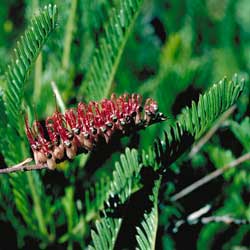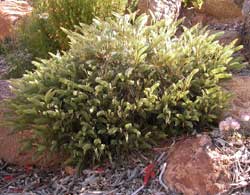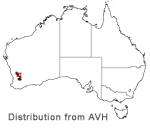Grevillea dryandroides
 subspecies dryandroides |
 subspecies hirsuta |
Phalanx Grevillea
Grevillea dryandroides C.A.Gardner
Grevillea
dryandroides, commonly known as Phalanx Grevillea, is a member of the Proteaceae
family. Endemic to Western Australia, it has extremely limited distribution,
occurring only in the Ballidu and Cadoux areas in south-western Australia. It
occurs in low open heath and Banksia woodland on sandy loam soils, over
laterite or clay. Grevillea dryandroides is a particularly hardy species,
adapted to hot-dry summers, cool-moist winters and is tolerant of moderate frosts. 
Two subspecies are recognized, subsp. dryandroides and subsp. hirsuta. Both taxa are now restricted to road verges and rail reserves in the extensively cleared Avon Wheatbelt region. Remaining populations are fragmented and face threats of disturbance by road and rail maintenance, weeds, grazing and fire. Subsequently, both taxa are now listed as Endangered, ranked as Rare Flora in Western Australia, protected by legislation.
A low, clumping shrub to 0.5m high, Grevillea dryandroides is distinguished by its suckering habit which spreads to 1m in diameter. Rigid branchlets support striking yellow-green or grey-green fern-like foliage which consists of deeply divided pinnate leaves, 7-14cm in length. Red toothbrush-like flower spikes appear during spring – summer and are terminally borne on long (up to 1m), trailing leafless peduncles (stems) which extend beyond the foliage. Differences between the two subspecies are minor, with the leaves in subsp. dryandroides being yellow-green and with shorter lobes (<10mm) as opposed to the persistently hairy grey-green leaves (lobes >12mm) of subsp. hirsuta. The flowers of subsp. dryandroides are also less conspicuous (3-4cm) than those of subsp. hirsuta (5.5-10cm). Spent flowers bear pubescent follicles (dry fruits) up to 1.6cm in length.
As it is highly adapted to the dry summer climate of south-western Australia and sensitive to prolonged moist periods, cultivation of Grevillea dryandroides is difficult in the humid regions of eastern Australia. Although seeds are available and take three months to germinate, horticulturally produced plants are generally obtained through cuttings or grafts.
Cuttings trimmed to two-thirds foliage and 5-10cm long are best taken from firm young stems of healthy plants in late winter (in the ACT) or spring. Rooting hormone (especially liquid form) can be applied to stimulate root growth, after which cuttings should become established in 8-12 weeks. As Grevillea dryandroides is not a vigorous grower, it is best to keep plants in tubes for several months (until almost pot-bound). Being adapted to well-drained sandy soils and sensitive to unsuitable soil types, plants produced by cuttings in eastern Australia are relatively short lived (< 2 years).
Grafting onto rootstocks from species such as G. robusta and G. ‘Poorinda Royal Mantle’ has improved this species adaptability and hardiness and extended its growing range and lifespan to 7-10 years. As a result grafting is becoming the favoured propagation method for this species. Although still limited in cultivation, Grevillea dryandroides is becoming more readily available from specialist growers. With its impressive grey-green foliage, subsp. hirsuta is the more commonly used form in cultivation.
Grevillea dryandroides can be grown in hot-dry and cool-wet climates and has been successfully grown in Victoria and the ACT. Although sensitive to warm/humid conditions, grafted specimens have been established in Sydney and Brisbane. It is best grown in full sun, in a raised garden bed of free draining, acid – neutral gravelly or sandy loam soil. With the correct soil type (gravelly mix) and minimal use of a low phosphorus slow release fertilizer, it also makes an excellent tub specimen. Requiring little summer watering, no fertilizer or pruning (except to remove spent flowers), Grevillea dryandroides is a low maintenance, ornamental species that is ideal for ground cover use or as an attractive feature to rockeries.
Text by Heather Brownlie (2004 Student Botanical Intern)
Derivation of the name: Grevillea dryandroidesGrevillea – Named after Charles Francis Greville (1749–1809), co-founder of London Horticultural Society, a patron of botany. dryandroides – Oides (Greek derivative) means ‘like’, refers to the resemblance of the foliage to members of the genus Dryandra. hirsuta – derived from the Latin term hirsutus, meaning hairy, refers to the leaf indumentum characteristic of this subspecies.
|
References
Association of Societies for Growing Australian Plants (ASGAP) The Grevillea Page - Grevillea dryandroides.
Website: http://farrer.riv.csu.edu.au/ASGAP/g-dryanl.htmlCommonwealth of Australia. (2000) Flora of Australia – Volume 17A, Proteaceae 2, Grevillea. Australian Biological Resources Study: Canberra / CSIRO: Melbourne.
Elliot, W.R. & Jones, D.L. (1990) Encyclopedia of Australian Plants Suitable for Cultivation: Volume 5. Lothian Publishing: Port Melbourne, Victoria.
Leigh, J., Boden, R. & Briggs, J. (1984) Extinct and Endangered Plants of Australia. MacMillan Company of Australia: Crows Nest, Victoria.
Olde, P. & Marriott, N. (1994) The Grevillea Book – Volume One. Kangaroo Press: Kenthurst, New South Wales.
Olde, P. & Marriott, N. (1995) The Grevillea Book – Volume Two. Kangaroo Press: Kenthurst, New South Wales.
McGillivray, D.J. (1993) Grevillea, Proteaceae: A Taxonomic Revision. Melbourne University Press: Carlton, Victoria.
Wrigley, J.W. & Fagg, M. (1989) Banksias, Waratahs and Grevilleas and all other Plants in the Australian Proteaceae Family. Collins Publishers Australia: Sydney, New South Wales.
![An Australian Government Initiative [logo]](/images/austgovt_brown_90px.gif)

